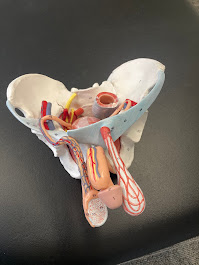When we hear the term pelvic floor, many people immediately think of women—especially in relation to pregnancy, childbirth, and postpartum recovery.
So, do men have a pelvic floor? Yes!
And what function does the pelvic floor in men serve?
Basically, the same function like in women.
It supports the bladder, prostate, and rectum. These muscles are essential for maintaining continence (control over bladder and bowel movements), sexual function, and pelvic stability.
Anatomy of the Male Pelvic Floor
Levator Ani Muscle Group
This is the largest group of muscle. It aids in supporting pelvic organs, fecal and urinary continence.Coccygeus (Ischiococcygeus) Muscle
Located behind the levator ani, this muscle helps support the coccyx and pelvic floor, contributing to the overall strength and stability of the area.External Urethral Sphincter
A circular muscle surrounding the urethra that allows voluntary control over urine flow.External Anal Sphincter
Controls the passage of stool and gas, allowing voluntary control over defecation.Bulbospongiosus Muscle
Surrounds the bulb of the penis and is involved in erection, ejaculation, and emptying the urethra after urination.Ischiocavernosus Muscle
Located along the sides of the penis, it helps maintain penile erection by compressing blood vessels and restricting blood flow out of the penis.
Pelvic Floor Dysfunction in Men
Men can experience pelvic floor dysfunction, which can cause symptoms like:
Urinary incontinence or urgency
Pain in the penis
Testicular pain
Difficulty emptying the bladder fully
Pelvic pain or discomfort
Erectile dysfunction or pain during ejaculation
Constipation or bowel issues
How can physical therapy help pelvic floor issues in men?
A pelvic floor physical therapist is like a coach for the muscles down there. We teach you simple exercises to strengthen weak muscles and relax the ones that are too tight or causing pain.
It’s not just about exercises either. We use gentle myofascial releases both externally and internally (ofcourse only if and when you are ready).We help you navigate diet, lifestyle changes to avoid straining your pelvic area during everyday activities, and give advice on habits that support your pelvic health.
With the right guidance and a little practice, many men see real improvements — less pain, better bladder control, and even improved sexual function. or pe
At EmpowerHeal Physical therapy, we are specialists in treating male pelvic floor disorders.

